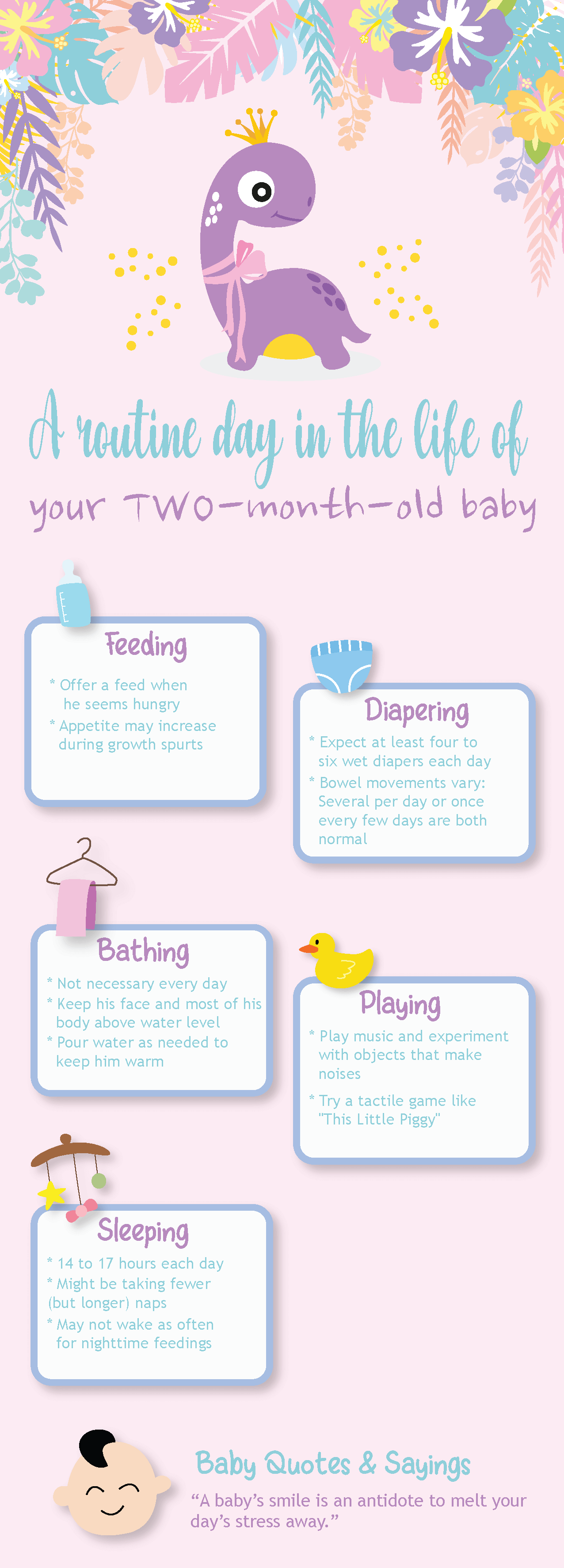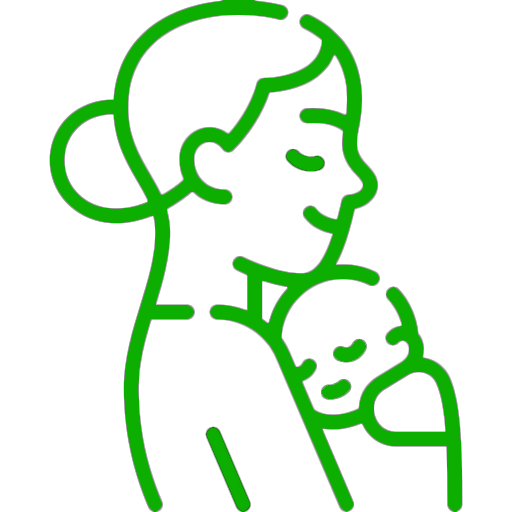Feeding Your 2-Month-Old Baby
Feeding your baby anytime he is hungry, which will be frequently, as 2-month-old babies are typically fed six to eight times per day. When he’s ready to eat, he’ll make sucking gestures, move his hand to his mouth, whine, or flex his arms and hands. Avoid overfeeding your baby by watching for indicators that he’s eaten enough, such as slowing or ceasing sucking or turning away. If your baby dresses asleep after a meal but appears alert, content, and active between feeds, he is certainly eating well. At this point, you may be able to skip one late-night feeding; as your baby’s stomach capacity expands, he may not be hungry until early morning.

Tracking wet and dirty diapers: The number of diapers you change might tell you if your kid is healthy and eating enough. Keep in mind that each infant is different and may pee every couple of hours or perhaps once every four to six hours. Less than six wet diapers may indicate mild dehydration. Keep track of how many diapers your baby normally uses. If the number of wet diapers drops significantly or your baby’s mouth appears dry, he may be dehydrated.
If you have any doubts, speak with your baby’s doctor. When it comes to poopy diapers, there is no “correct” number either. Two-month-old babies can poop numerous times per day to once per week. If your infant is pooping less than usual but the stools are soft and he or she is generally healthy, there is no need to be concerned. If you are concerned, your baby’s healthcare provider will be able to check to see if everything is fine.
How Much Sleep Does a 2-Month-Old Baby Need?
At 2 months old, your kid may be sleeping 14 to 17 hours each day. She may spend more time attentive and awake during the day, and while she may prefer fewer naps, they may be of greater duration. At this point, some (but not all) babies can sleep through the night, or for six to eight hours in a row.
Regular bedtimes and naptimes, as well as pleasant sleeping hours, provide your child with an excellent start in life, contributing to her overall health and well-being. Although it may take some time for evening habits to develop, you may help your baby get started by making midnight feeds as peaceful as possible. Keep the lighting low, don’t speak much or loudly, and lay her directly back to sleep on her back after the feeding and diaper change. Watch these excellent sleep tips for more information.
Your Baby’s Health: Dealing With Diaper Rash
Skin conditions:
Diaper rash
- A moist or soiled diaper that comes into contact with infant skin for an extended period of time might create a red rash on the diaper area. To avoid diaper rash, change wet or poopy diapers as quickly as possible, wipe the region clean after each change, and expose your baby’s bottom to air as much as possible. These methods will help the rash heal and keep it from recurring. For more information, watch this short film on diaper rash treatment and prevention.
Heat rash
- These tiny, red bumps usually form on the neck, arms, legs, or diaper area in hot, humid weather. Instead of applying skin ointments, cool the affected area with water and then thoroughly dry it. Keep your baby cool and dry by dressing her in cool, dry clothing and keeping her out of the sun. With this form of treatment, heat rash normally goes away after a few days.
Eczema
- Eczema could be the cause of your baby’s red, itchy, scaly patches of skin in the crooks of her elbows and knees. Your baby’s doctor will be able to establish a diagnosis and propose treatment options. It may help to use mild, unscented baby soaps on your baby and her clothes and sheets, outfit her in soft, non-prickle clothing, and bathe her no more than three times per week.
Coughing
- If your 2-month-old baby starts coughing, it’s a sign that her airways are irritated. Coughs can be caused by a variety of respiratory disorders, ranging from the common cold to pneumonia. If your infant is coughing, contact your baby’s healthcare provider; however, if the coughing is accompanied by fever or difficulty breathing, take your baby to the doctor straight away for treatment or guidance.
Allergies
- If your baby appears unhappy or cries excessively, vomits up most of her meals, has very watery or bloody poops, or develops a rash, she may have a food allergy or sensitivity. Your baby’s doctor will need to investigate probable causes and establish a diagnosis.
A Day in the Life of Your Baby
Every baby is different, but here’s a glimpse of what a typical day could look like with your baby.

Your Parenting Experience: Getting Back to Work
Depending on your circumstances, several issues such as income, maternity leave possibilities, and general family considerations may come into play while deciding whether or not to return to work. Allow yourself some leeway if possible, as you may change your mind about returning to work when the time comes. It’s natural to feel sad, frightened, or apprehensive about how your child will adjust when you return to work. If your partner is not staying at home with your newborn, the goal is to find child care that both you and your kid enjoy. You can also think about hiring some help at home so you can spend more time with your kid without being distracted.
Establish a routine
Start planning out your regular weekday a couple of weeks before you return to work. Consider how early you will need to get up in order to leave the house on time, how long your commute will be when you factor in dropping your kid off at daycare, or if you are hiring a nanny, and what time will they need to arrive? What about evenings, and when do you plan on pumping if you’re nursing? Remember to include your baby’s naps and feeding times, and don’t forget to leave time for those all-important baby snuggles!
Once you have this draft schedule, you will have a good notion of what you may need to alter to make the transition back to work as easy as possible for all of you. It’s a good idea to start adjusting your daily routine at least a week before returning to work so that both you and your kid are accustomed to the new schedule.
Obviously, your baby still needs to be fed often at 2-months old, and it may appear difficult to ‘get them on a routine.’ Many working parents strive to change things they can control to help in this situation. Things like getting up 30 minutes before your baby to shower and be ready first.
Babies thrive on routine, and it has been scientifically demonstrated that if a habit is formed, they will fall asleep sooner and stay asleep longer. You can do it!
Child Care Planning
You may have access to a variety of child care options, including
- your parents or other family members
- a babysitter
- a daycare centre
- in-home care, either for your baby alone or in a group setting with other children
- a nanny
- or a combination of the above.
When looking for child care, keep in mind that the most important thing is that your baby is happy and developing normally under the care you choose. Request references from other parents or your baby’s healthcare professional. Speak with possible caregivers in-depth, see them with your infant for a day or two, check references and conduct background checks, and follow your intuition. You should always keep an eye on your baby’s health and rethink your decision if necessary.
Expressing Breast Milk at Work
Returning to work can be stressful for some women, and it may diminish your breast milk production (together with other kinds of stress), especially if you are unable to pump as often as you would like. Until your infant becomes one year old, your employer is required by law to provide you with time and a facility — other than a lavatory — to express breast milk. If you are concerned that your milk supply is running low, read up on how to improve breast milk supply and get assistance from your healthcare provider or lactation consultant.
Finding Help at Home
You may require assistance with cooking, household tasks, or errands as you return to work, or just because you require an additional pair of hands. Here are some things to remember:
- Make sure you have someone you can rely on to lighten the weight rather than add to it.
- Determine when you will require assistance and ensure that the assistant can commit to this plan on a consistent basis.
- Be specific about what you require assistance with, and consider putting it in writing.
- If the assistant is unable to attend or becomes ill, request adequate notice.
- Plan B should include a babysitter or a neighbour who can step in at the last minute.
- Consider receiving a background check and verifying that you have a valid driver’s license.
- If the person’s role includes caring for your baby, request that they take a baby first aid course.
This page is based on professional advice from reputable medical and government organizations, such as the American Academy of Pediatrics and the American College of Obstetricians and Gynecologists. This page’s material should not be used in place of professional medical advice. For a complete diagnosis and treatment, always seek the advice of a medical expert.














Leave a Reply
View Comments